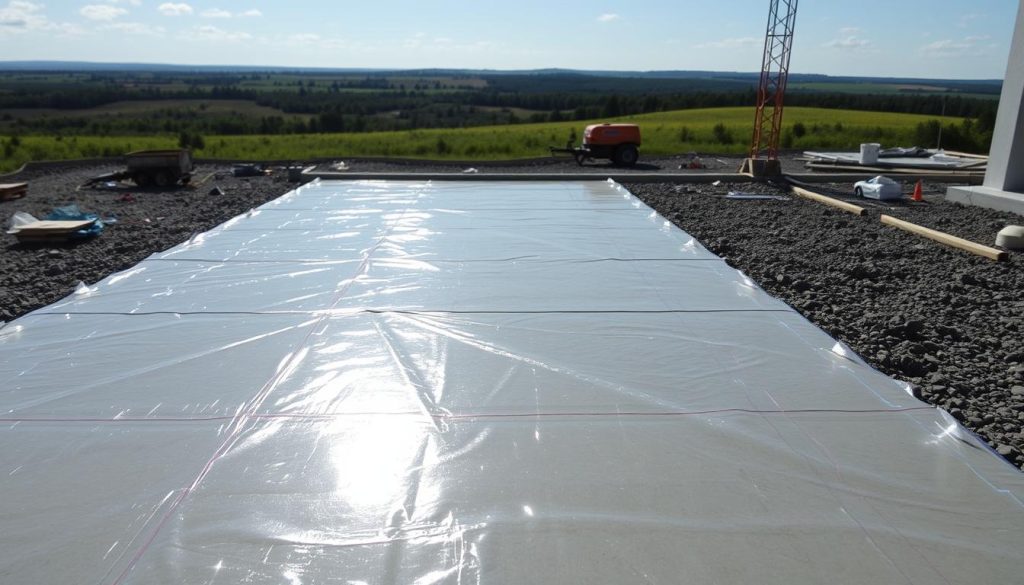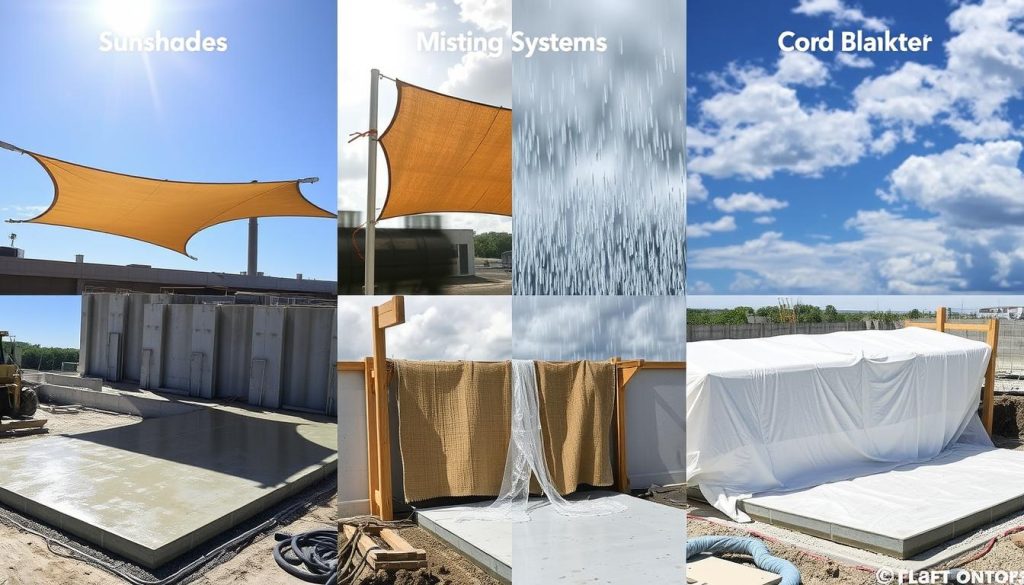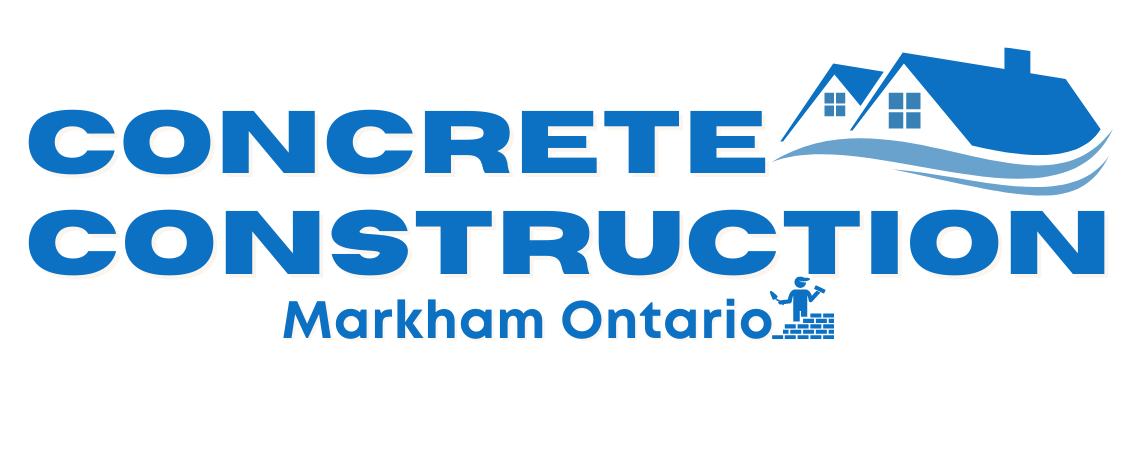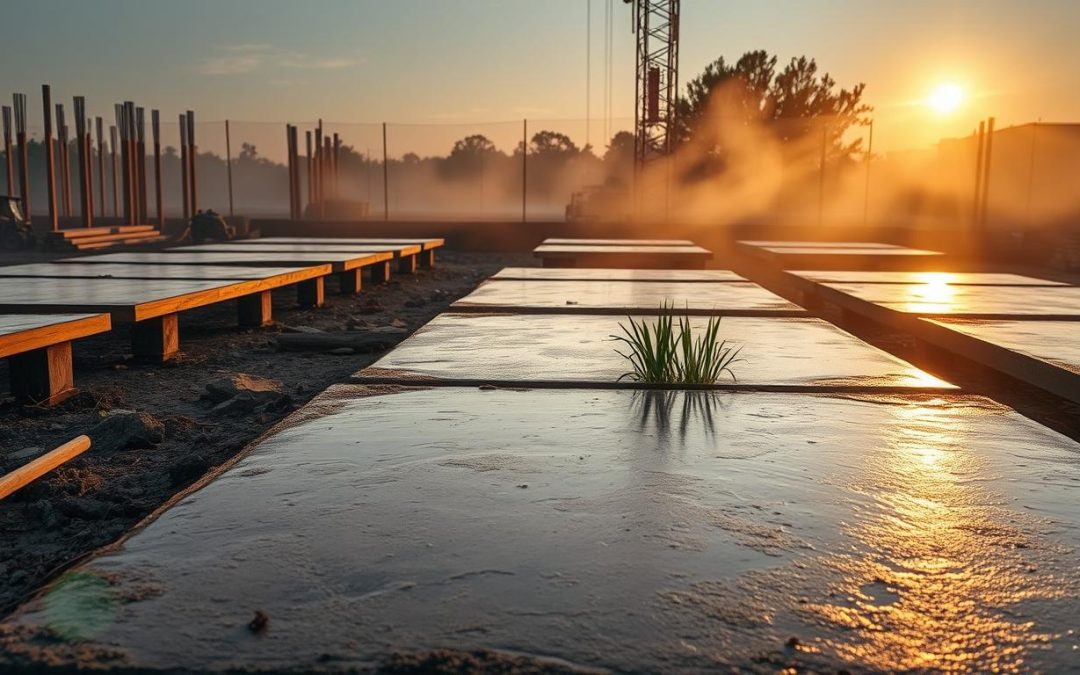Concrete curing is key in building, making sure it’s strong and durable. It involves keeping the right temperature and moisture. This lets the concrete hydrate and get stronger. Knowing how to cure concrete is vital for good construction.
Learning about concrete curing helps ensure your projects succeed. It usually takes 24 to 48 hours for concrete to dry. This time depends on the temperature and the concrete mix.
Key Takeaways
- Concrete curing is essential for the first 24 to 48 hours after placement to maintain moisture and temperature for proper hydration and strength development.
- The standard curing time required for sufficient strength and durability is 7 days.
- Factors such as temperature, humidity, thickness of the pour, and type of concrete mix can significantly affect the curing time.
- Higher temperatures can accelerate hydration but also increase the risk of cracking if not managed properly.
- Regular checks of humidity, temperature, and moisture levels during the curing process can help ensure uniform hydration and detect early curing issues.
- Understanding different concrete curing methods and types of concrete curing is critical for optimal results.
- Concrete curing methods, including water curing and membrane curing, can help ensure proper hydration and strength development.
Understanding the Concrete Curing Process
The concrete curing process is key in building any concrete structure. It involves chemical reactions between cement and water. This creates a hard, durable, and strong concrete matrix. The importance of curing concrete is huge, as it affects the structure’s strength, durability, and quality.
During curing, the hydration reaction happens. This is when cement reacts with water to form a crystalline structure. To ensure the concrete reaches its full strength, controlled temperatures and moisture are needed. The curing techniques used depend on the climate, cement type, and desired concrete strength.
The timeline of concrete strengthening is vital. Usually, concrete gains most of its strength in the first 28 days. The American Concrete Institute (ACI) suggests a 7-day curing period to reach 70% of the specified strength. Proper curing leads to better compressive and flexural strength, essential for load-bearing structures.
Chemical Reactions During Curing
The curing process involves complex chemical reactions. The hydration reaction is the main one, forming a crystalline structure. It’s critical to keep the right temperatures and moisture levels. This directly impacts the concrete’s strength and durability.
Hydration Process Explained
The hydration process is a critical stage in curing. It’s the reaction between cement and water, forming a crystalline structure. This process needs controlled temperatures and moisture to ensure the concrete reaches its full strength.
Timeline of Concrete Strengthening
The timeline of concrete strengthening is key. Here are the typical stages:
- Initial curing: 24 to 48 hours
- Intermediate or Partial Curing: 7 days
- Final curing: 14 to 28 days
By understanding the concrete curing process, contractors and builders can ensure strong, durable, and long-lasting structures.
Why Proper Concrete Curing is Critical for Construction
Proper concrete curing is key for getting the right strength, durability, and volume stability. The importance of concrete curing is huge, as it affects how long and well concrete structures last. If curing is not done right, the concrete might not be strong, could crack, and might not last long.
Using accelerated concrete curing can make concrete better against weather, heavy use, and freezing. The best curing time is usually 3 to 7 days for the start, and it takes up to 28 days or more for full strength. Things like weather, temperature, and humidity play a big role in how well the concrete cures.
Some important things to think about for good concrete curing are:
- Keeping moisture loss steady for even curing
- Applying curing compounds to keep moisture in
- Watching temperature and humidity to avoid losing too much moisture
By using the right concrete curing methods and understanding its importance, construction projects can make sure their structures last a long time. The American Concrete Institute (ACI) offers advice and rules for curing, which can guide the process.
Essential Factors Affecting Concrete Curing
Concrete curing is a complex process. It can be influenced by temperature, humidity, and environmental conditions. Understanding these factors is key to proper concrete curing methods. This ensures the concrete’s strength and durability.
The ambient conditions, like temperature and humidity, are very important. Higher temperatures can speed up hydration but can also cause cracking. Low temperatures slow down curing, so keeping a consistent temperature between 50-90°F is important. Also, maintaining proper humidity levels is vital to prevent moisture loss and ensure hydration.
Other factors that affect concrete curing methods include protective measures like plastic sheeting. These measures reduce evaporation rates during curing. The type of reinforcement, such as synthetic or metal fibers, also impacts durability. By understanding these factors and using the right types of concrete curing methods, contractors can ensure successful projects.
Some key considerations for curing of concrete include:
- Maintaining consistent temperature and humidity levels
- Using protective measures to reduce evaporation rates
- Selecting the right type of reinforcement for the project
- Monitoring the curing process to prevent mistakes
Types of Concrete Curing Methods
Concrete curing is key to making sure concrete lasts long and works well. There are many ways to cure concrete, each with its own benefits and drawbacks. The right method depends on the project and the environment.
Water curing is the most effective, perfect for certain jobs. It keeps the concrete moist by spraying or fogging it. This is vital in hot, dry places where moisture can quickly evaporate.
Other methods, like membrane curing and steam curing, also work well but need special care. Membrane curing uses a protective layer to keep moisture in. Steam curing speeds up the curing process with steam. The choice depends on the concrete type, the weather, and how strong the concrete needs to be.
Here are some key considerations for different concrete curing methods:
- Water curing: suitable for most concrete applications, but requires a continuous water supply
- Membrane curing: effective for preventing moisture loss, but may require specialized materials and application techniques
- Steam curing: can accelerate the curing process, but may require specialized equipment and expertise
The curing process takes 3 to 7 days at first and can go up to 28 days or more for the best strength. The best temperature for curing is 50°F to 60°F. The humidity should be 80% to 85% for good hydration. Knowing about these methods helps ensure concrete lasts a long time.
Water Curing Techniques
Water curing is a key step in making concrete strong. It involves keeping the concrete wet for a while. This helps the concrete to hydrate and harden properly.
There are several ways to water cure concrete. These include the ponding method, sprinkler system, and wet burlap. The ponding method uses a water pond on the concrete. The sprinkler system sprays water on it a few times a day. The wet burlap application uses soaked burlap to keep it moist for a few days.
Water curing makes concrete stronger and less likely to crack. It’s important to use clean water for this process. Knowing these methods helps contractors choose the best one for their projects.
Advantages of Water Curing
- Improves strength and durability of concrete structures
- Reduces the likelihood of cracking in concrete
- Enhances the overall quality of the concrete
Using these water curing techniques can greatly benefit a project. It can make the concrete 15-30% stronger. It also improves the surface’s abrasion resistance by up to 20%. These are key benefits of effective curing methods.
Membrane Curing Approaches
Membrane curing is a method to keep concrete moist. It uses a membrane to hold moisture and help the concrete hydrate. This can be done with curing compounds or sheet membranes.
There are many types of membrane curing compounds. Acrylic and sodium silicate are two common ones. They are applied with a spray or roller. They create a thin, waterproof layer that stops moisture from escaping.
Membrane curing has many benefits. It keeps moisture in and stops it from evaporating. This reduces the chance of surface defects and helps the concrete cure evenly. It’s also good for use in hot and dry climates.

Choosing the right membrane curing method is key. You need to think about the concrete type, the environment, and what you want to achieve. The right method ensures a successful concrete project.
Some popular methods include:
- Applying a curing compound to the surface of the concrete
- Using a paper or plastic sheet membrane to create a barrier against moisture evaporation
- Utilizing a combination of both to achieve optimal results
Understanding membrane curing helps contractors make better choices. Whether it’s for concrete curing methods or types of concrete curing, it’s a key part of the process. It promotes hydration and strengthens the concrete.
Advanced Concrete Curing Technologies
Advanced concrete curing technologies have changed the construction world. They offer quick and effective ways to cure concrete. Steam curing is one method that speeds up hydration, making concrete stronger faster.
It uses steam to apply heat and moisture. This leads to accelerated concrete curing and better durability.
Electrical curing is another method. It heats the concrete using electrical resistance. This promotes curing of concrete and boosts its strength.
Chemical curing compounds also speed up the curing process. They are applied to the concrete surface. This helps accelerate concrete curing and reduces cracking risks.
Using a mix of new and old methods is key. Construction experts can pick the best approach for their projects. Advanced curing technologies increase productivity, cut costs, and improve quality.
For example, advanced curing can cut curing times by up to 50%. This lets manufacturers double their output without needing more space. It also reduces waste and costs, making it a great choice for improving best practices for concrete curing.
Common Concrete Curing Mistakes to Avoid
Small mistakes in concrete curing can cause big problems. These include cracks, structural failures, and weaker strength. Knowing common mistakes helps avoid them. It’s key to watch and manage the curing process well.
Common errors include timing errors and moisture control issues. These can cause uneven hydration and weaker strength. Temperature management problems also happen, affecting the curing speed and outcome.
Timing Errors
Timing is everything in concrete curing. Applying the method too late can cause cracks and failures. Too early, and it won’t hydrate properly, leading to weaker strength. To avoid these, follow best practices and proven techniques.
Moisture Control Issues
Keeping moisture in check is essential. Too much can cause uneven hydration and weaker strength. Use the right curing process and follow guidelines to manage moisture well.
Temperature Management Problems
Extreme temperatures can impact the curing process. To avoid issues, follow best practices and use proven techniques. This ensures the concrete cures correctly, regardless of temperature.
Special Considerations for Different Weather Conditions
Weather conditions greatly affect concrete curing methods. The best temperature for pouring concrete is between 10°C (50°F) and 21°C (70°F). Temperatures should not go below 4°C (40°F) or above 32°C (90°F).
High temperatures speed up the concrete curing process. But, low temperatures slow it down or even stop it.
In hot weather, covering the concrete is key for its strength. For cold weather, using insulated blankets or heated enclosures is necessary to prevent freezing. Curing blankets can make curing 2.8 times faster than traditional methods.
Here are some key considerations for different weather conditions:
- High humidity can make curing take longer, while low humidity can cause drying too fast, leading to cracks.
- Too much rain or snow weakens the concrete; dry weather is better.
- Strong winds can cause moisture loss, leading to cracks; calm weather is best.

Understanding weather conditions is key for a successful concrete curing process. Whether it’s hot or cold, picking the right types of concrete curing methods is vital. This ensures your concrete is strong and durable.
Quality Control During the Curing Process
Ensuring concrete quality during curing is key for its strength and durability. It’s important to check humidity, temperature, and moisture levels often. Adjusting curing methods as needed is also vital. Proper concrete curing techniques help avoid defects and boost concrete quality.
Quality control includes moisture testing methods and strength testing procedures. It also involves keeping detailed records. The American Concrete Institute (ACI) suggests a minimum 7-day curing period for concrete to reach 70% of its strength.
Key Quality Control Measures
- Regular testing, including slump tests, air content tests, and strength tests
- Monitoring workability to facilitate effective placement and compaction
- Maintaining optimal temperature to support proper strength development
- Implementing a quality control program to reduce defects and enhance structural integrity
By following these quality control steps, contractors can make sure their concrete meets standards. Accelerated concrete curing methods, like live steam curing, can also speed up the process. Regular monitoring and testing are essential for quality concrete.
Benefits of Professional Concrete Curing Services
Following best practices for concrete curing is key to getting the best results. Professional concrete curing services offer many benefits. These include stronger and more durable concrete, less maintenance, and a longer lifespan. They use methods like water curing and membrane curing to ensure the concrete is fully cured.
Some of the main benefits of professional concrete curing services are:
- Improved strength and durability: Proper curing can increase concrete strength by up to 30% compared to uncured concrete.
- Reduced maintenance: Adequate curing is linked to a reduction in shrinkage and an increase in resistance to natural wear and tear.
- Increased lifespan: Concrete that is cured properly can achieve its design strength 7 days earlier than improperly cured concrete, and can last up to 50% longer.
Investing in professional concrete curing services means your concrete will be cured effectively. This leads to a stronger, more durable, and longer-lasting structure.
Proper curing can also prevent up to 80% of surface cracking in concrete structures. It can make the surface up to 25% more durable than air-dried methods. With professional concrete curing services, you can get the best results and ensure your concrete structures last a long time.
Conclusion: Mastering Concrete Curing for Optimal Results
Getting concrete curing right is essential for your construction projects’ long-term success. By sticking to the best practices, you can make your concrete last longer. This means keeping the right temperature and moisture levels and using the latest concrete curing methods.
Good concrete curing helps avoid problems like cracks and dust. It also makes the concrete stronger. With the right methods, you can increase the concrete’s strength by up to 50%. It also cuts down on durability issues by about 30% in tough environments.
Whether it’s a small home project or a big commercial build, knowing how to concrete cure is key. Working with experts and using new technologies can make your curing process better. This leads to results that impress your clients.

